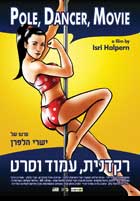
Pole, Dancer, Movie 2013
Distributed by Ruth Diskin Films Ltd., P.O.Box 7153, Jerusalem, 91071, ISRAEL
Produced by Halpern Films Ltd.
Directed by Isri Halpern
DVD , color, 55 min.
Sr. High - General Adult
Dance, Gender
Date Entered: 05/21/2014
Reviewed by Monique Threatt, Indiana University, Herman B Wells Library, Bloomington, INThis feature-length film by the irascible and confrontational director, Isri (Israel) Halpern is quite the eye-opener. Since the early 1980s, the pole and pole dancing have become synonymous with seedy strip clubs as popularized in music videos such as Motley Crew’s “Girls, Girls, Girls.” However, within the past 10 years, the pole is gaining notoriety as a tool for endurance training, exercise, increasing flexibility and strength. Pole dancing is a form of art which encompasses athleticism, acrobatic maneuvers, ballet, jazz, pop, and more. This video diary documents Neta Lee Levy’s journey as she prepares to train, enter, and win the 2011 European Pole Dance Championship in Vught, Netherlands.
Athletic, confident, committed, and determined are just a few words to describe Neta. She is brutally honest about her early introduction to the world of being a stripper and the pole. As a young woman looking for work in Japan, a stranger introduces her to a world of easy money and strip clubs. She doesn’t deny that she has a life-long passion for dance, and seems to revel in the attention and admiration of dancing for others. Upon her return from Japan to Israel, and with support from her family, Neta seizes the opportunity to apply for a small business loan and open the first pole dance studio in Israel. She believes pole dancing is representative of the anti-establishment, and it empowers women to defy traditional roles. She is determined to succeed against all odds to be the best in her profession. She works and trains as hard as any competitive athlete. Her performances are superbly well choreographed complete with costumes, music, and theatrics worthy of a Cirque du Soleil show.
Interestingly, the filmmaker may be out-of-frame, but his presence is clearly ubiquitous. He does not shy away from asking Neta uneasy questions i.e., is she required to dance naked, or provide sex in exchange for money. She is visibly upset with his line of questioning, yet these heated verbal interactions between Isri and Neta occur quite often throughout the film. Conversely, she is forced to take pause, soul-search, and then deliver raw and honest answers. Perhaps the filmmaker has found a crack in what appears to be Neta’s tough-as-nails exterior. He is also able to capture her emotional highs and lows particularly as she interacts with the loan officer, her admittance and acceptance to train dancers at a strip club in Tel Aviv, her defense of pole dancing in the wake of protestors, and her perseverance to tackle political bureaucracy as a person of Middle Eastern descent competing in a championship for Europeans.
In closing, this film invalidates perceived stereotypes, and sheds light on a growing art form that is sweeping the nation. It gives some credibility and exposure to the art of pole dancing. A few years ago, special interest groups tried to petition the Olympic Committee to have pole dancing recognized as an Olympic sport. This viewer clearly remembers the backlash and jokes associated with the petition. However, after watching this film, this viewer hopes pole dancing will become a recognized sport at the 2016 Olympics. As with most independent films made today, the film is shot in high definition and dance tracks include music by Tina Turner, Madonna, and others. I highly recommend this film for public and academic libraries. In Hebrew with English subtitles.
Awards
- Best Film Award, DocAviv film festival, 2013